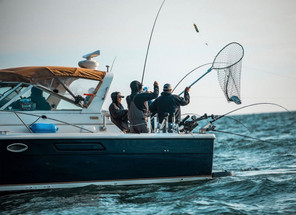Posted by Will Allen on 21st Jul 2025
Salmon Fishing on the Niagara Bar
The Niagara Bar, a legendary fishing hotspot at the mouth of the Niagara River where it meets Lake Ontario, is a premier destination for salmon fishing in Western New York. Known for its nutrient-rich waters, strong currents, and proximity to deep drop-offs, the Niagara Bar attracts massive king and coho salmon, making it a bucket-list location for anglers. The Niagara Bar offers thrilling opportunities to land trophy salmon. This article explores why the Niagara Bar is a salmon fishing paradise, the best techniques, prime locations, and tips for a successful trip from ports near Niagara Falls, New York.
Why the Niagara Bar?
The Niagara Bar’s unique geography makes it a salmon magnet. Formed by sediment deposits from the Niagara River, the bar is a shallow, nutrient-rich shelf that drops sharply into Lake Ontario’s deeper waters (100-300 feet). This transition zone concentrates baitfish like alewives, drawing hungry salmon from spring through fall. King salmon, often exceeding 20 pounds, dominate catches, while coho salmon, steelhead, lake trout, and the occasional Atlantic salmon add variety. The bar’s proximity to ports like Wilson, Olcott, and Niagara Falls makes it accessible, with a robust charter industry and public access points catering to all anglers.
Prime Fishing Locations
The Niagara Bar spans roughly from the Niagara River’s mouth to several miles offshore, with key fishing zones:
- The Bar Proper: The shallow shelf (20-50 feet) near the river mouth is ideal for spring and early summer fishing, as salmon stage here before moving deeper. Trolling along the bar’s edges yields kings and cohos.
- The Drop-Off: Beyond the bar, depths plummet to 100-300 feet, creating a thermocline where salmon congregate in summer and fall. Trolling in 80-150 feet of water is productive for larger kings.
- Red Can and Green Can Buoys: These navigational markers near the bar are hotspots, as currents push baitfish and salmon into these areas. Focus on the 50- to 100-foot depths around the buoys.
- Niagara River Mouth: The river’s outflow attracts salmon, especially in fall (September-October) when kings run upstream to spawn. Shore anglers and boaters target this area with great success.
Trolling Techniques for Salmon
Trolling is the go-to method for targeting salmon on the Niagara Bar, allowing anglers to cover vast areas and present baits at precise depths. Key techniques include:
- Downriggers and Divers: Downriggers are essential for getting baits to 50-100 feet and beyond, where salmon often hold. Dipsy divers complement downriggers, allowing multiple lines at varying depths. Set divers to run 20-50 feet below the surface for cohos and deeper for kings.
- Bait and Lures: Flashers paired with cut bait (herring or alewives) or flies mimic injured baitfish, triggering aggressive strikes. Spoons like Moonshine Glow or Michigan Stinger in green, blue, or chartreuse are deadly. Run baits 50-100 feet behind the boat.
- Speed Control: Troll at 2.0-3.0 mph, adjusting based on water temperature and salmon activity. Currents can be extreme on the Niagara Bar. A Fish Hawk Electronics system provides speed information at depth which is often different than speed-over-ground.
- Tackle Setup: Use 15- to 20-pound test monofilament or fluorocarbon line for durability. A 9- to 10-foot medium-heavy rod with a high-capacity reel handles the fight of a 20-pound-plus king. Lead-core, copper, and weighted steel are also popular choices on the bar.
Charters and Access Points
Ports like Wilson (Wilson Harbor) and Olcott (Newfane Marina) are the primary launch points for the Niagara Bar, offering modern facilities, boat launches, and fish-cleaning stations. Charters such as Vison Quest Sport Fishing in Wilson and Thrillseeker Sportfishing and Dirty Goose Sport Fishing in Olcott provide guided trips with top-tier gear and local knowledge. These operators use advanced sonar and GPS to pinpoint salmon, making them ideal for beginners or those chasing trophies. Book charters early, especially for peak summer and fall seasons.
Seasonal Strategies
Timing is critical for Niagara Bar salmon fishing:
- Spring (April-May): Salmon stage in shallower waters (20-50 feet) near the bar. Troll with spoons or stickbaits near the surface for cohos and smaller kings.
- Summer (June-August): As water warms, salmon move to deeper waters (80-150 feet). Focus on the drop-off zones with downriggers and flashers.
- Fall (September-October): The fall run brings kings to the river mouth and shallows. Troll or cast near the bar’s edges or river outflow for spawning fish.
Tips for Success
- Monitor Weather: Lake Ontario’s conditions can be volatile. Check forecasts and avoid high winds, as waves can disrupt trolling.
- Use Technology: A quality fish finder is crucial for locating thermoclines and salmon schools. A Fish Hawk will provide real-time water temperature data at depth.
- Pack Smart: Bring polarized sunglasses, sunscreen, and warm layers, as mornings on the lake can be chilly even in summer.
- Hire a Charter: For first-timers, a guided trip maximizes success and minimizes guesswork.
- Respect the Fishery: Follow catch limits and handle fish carefully to preserve the Niagara Bar’s world-class trout & salmon population.
Conclusion
Salmon fishing on the Niagara Bar is an exhilarating experience, combining the thrill of battling trophy kings and cohos with the scenic beauty of Lake Ontario’s southern shore. With prime trolling grounds, accessible ports, and a thriving charter industry, the Niagara Bar delivers unforgettable angling adventures. Whether you’re trolling the drop-offs or casting from the Olcott Pier, the bar’s rich waters promise heart-pounding action. Pack your gear, book a charter, and head to the Niagara Bar for a salmon fishing trip that will leave you hooked.

